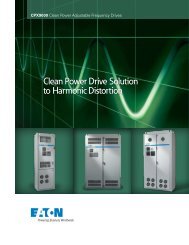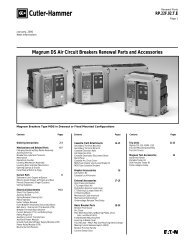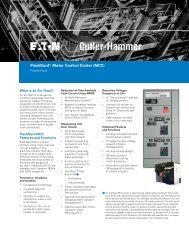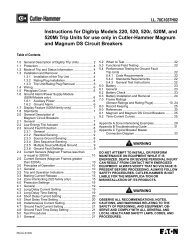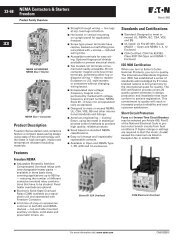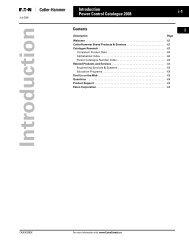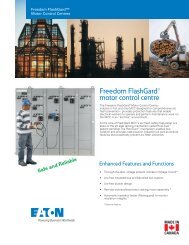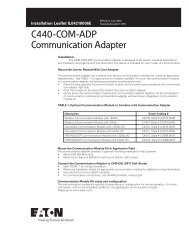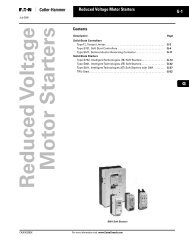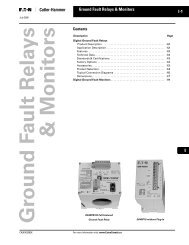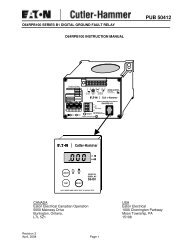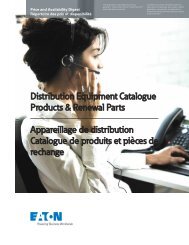molded case circuit breakers - Eaton Canada
molded case circuit breakers - Eaton Canada
molded case circuit breakers - Eaton Canada
Create successful ePaper yourself
Turn your PDF publications into a flip-book with our unique Google optimized e-Paper software.
282<br />
SWITCHGEAR (MEDIUM VOLTAGE) FUSIBLE<br />
Load Interrupter Metal Enclosed Switchgear<br />
PRODUCT DESCRIPTION<br />
Approximately 40 years ago,<br />
Westinghouse began to produce a threephase<br />
load interrupter medium-voltage<br />
switch housed in a metal enclosure. The<br />
switch is rated 5 to 15 kV and 600 to 1200<br />
amperes. This switch was an economical<br />
visible disconnect used primarily for unit<br />
substations, main service entrance and<br />
distribution of service entrance via a lineup<br />
of these switches. Most switches have<br />
a fuse for <strong>circuit</strong> protection on the load<br />
side. The switch structure consists of 11<br />
gauge structural steel. The appearance of<br />
the switch has not changed drastically<br />
over the years.<br />
PRODUCT HISTORY<br />
Originally a Westinghouse Product<br />
Metal enclosed load break air interrupter<br />
switches were first produced in 1952<br />
under the name Load Break Fusible (LBF)<br />
at M & R facilities around the country. In<br />
1964, the manufacturing of the product<br />
was consolidated in the Cincinnati, OH<br />
facility. The product was discontinued in<br />
1972 and replaced with Westinghouse<br />
Load Interrupter (WLI) having many<br />
design changes and improvements. Parts<br />
for the two products are incompatible but<br />
the current WLI design can be added to<br />
existing LBF lineups. The WLI product line<br />
PRODUCT HISTORY TIMELINE<br />
was moved to the Sumter, SC manufacturing<br />
facility in 1979.<br />
As stated earlier, LBF and WLl look similar<br />
in design. They can be differentiated by<br />
the nameplate located behind the operating<br />
handle access door. The front is largely<br />
covered by the main door, with viewing<br />
window, providing access to the switch<br />
and fuse compartment. A smaller access<br />
door on the main door allows access to<br />
the switch operating mechanism. Upon<br />
opening the main door, the switch in the<br />
Page Product 1950 1955 1960 1965 1970 1975 1980 1985 1990 Present<br />
283 Westinghouse LBF<br />
284<br />
WLI + MVS<br />
➃<br />
➁<br />
➂<br />
➉<br />
➁<br />
➄<br />
➅<br />
➆<br />
➀<br />
➇<br />
➈<br />
Standard Manually Operated Fused WLI<br />
Switch<br />
➀ Switch Position Indicator/Operator<br />
Mechanism<br />
➁ Provisions for Padlocking Door<br />
➂ Inspection Window<br />
➃ Full Height Main Door<br />
➄ Door Stop, Foot Operated<br />
➅ Grounded Metal Safety Barrier<br />
➆ Door Interlock<br />
➇ Switch Interlock<br />
➈ Interphase Barrier<br />
➉ Switch Operator Mechanism Access<br />
Door<br />
upper part of the structure is covered by a<br />
protective screen barrier which allows<br />
visual inspection. The fuses, when provided,<br />
are located in the lower part of the<br />
structure, and are readily visible for easy<br />
maintenance when the main door is open.<br />
The rear of the switch structure is generally<br />
used for cable entrance and/or exit.<br />
Access to the cable entrance/exit area<br />
is via a rear cover or door.<br />
March 2001



